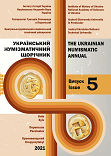ГРОШОВИЙ ОБІГ ОЛЬВІЇ ПОНТІЙСЬКОЇ НА ФІНАЛЬНОМУ ЕТАПІ ІСТОРІЇ МІСТА
MONEY CIRCULATION OF OLBIA PONTIUS AT THE FINAL STAGE OF CITY’S HISTORY
Author(s): Borys MagomedovSubject(s): Archaeology, Cultural history, Regional Geography, Economic history, Ancient World
Published by: ДВНЗ Переяслав-Хмельницький державний педагогічний університет імені Григорія Сковороди
Keywords: Northern Black Sea Coast; Olbia; Roman period; Chernyakhiv culture; Goths; denarius; coin find; money circulation;
Summary/Abstract: The aim of the study is to explain the unusually high for provincial city percentage of Roman denarii among the coins of ancient Olbia. Research methodology - principles of science, historicism, objectivity, generalization, historical-genetic and historical-typological. Scientific novelty. Some researchers of Olbia connected the final stage of its history with presence of barbarians, carriers of the Chernyakhiv culture (the second third of 3rd - the beginning of 5th c., the dominant population - the Goths). Other researchers believed that the material culture of the city retains its ancient character to the end. Modern analysis of finds from the late Roman layers of Olbia and its surroundings demonstrates undeniable Chernyakhiv analogies and shows the inclusion of the city in political and economic system of barbarians. The truth of this statement can be verified by comparing the numismatic materials of Chernyakhiv culture and Olbia of Roman times. In the area of this culture within the borders of former USSR, finds of more than 26 thousand Roman coins have been recorded. Coins modern to this culture (3rd - 4th c.) are a minority, and 78,7% are represented by earlier silver denarii of the 1st - 2nd c. The barbarians received these denarii from Rome as military contributions and subsidies or wage to military units. Some coins were put into circulation for internal payments. P. Karyshkovsky made statistical calculations of coins of the 1st - 4th c. from Olbia and found some local peculiarity. Unlike other ancient cities of Northern and Western Black Sea coast, among the Roman and provincial coins found in Olbia, the majority are denarii of the 1st - 2nd c.: 53,5% of finds. However, in Histria city (Western Black Sea Coast) denarii make only 17,3%. The peculiarity of Olbia collection can be explained by the history of this city. After the Gothic conquest (between the late 250s and early 270s), Olbia was reborn as small fortified town, a trade and craft center inhabited by Goth barbarians. The distribution of coin finds from the second half of 3rd to the beginning of 5th c. corresponds to the situation in Chernyakhiv culture. Issues of coins of that time came to its population in small quantities. However, the barbarians owned a large mass of old denarii of 1st – 2nd c. Some of them fall into the cultural layer of Olbia, which creates a false picture of money circulation of the city in early Roman times. The percentage of such denarii in Olbia without the participation of the later “Chernyakhiv” addition should be close to the percentage of denarii in Histria (17,3%). Conclusions. A feature of the money circulation of Olbia in Roman times is relatively large number of finds of denarii of the 1st - 2nd c. This can be explained by the fact that in the third quarter of 3rd c. the city was included into political and economic system of Chernyakhiv culture, where the main currency was the silver denarii of the 1st - 2nd c., which by that time were out of circulation in the Empire. The Olbia collection of Roman coins should be divided into the “Ancient” and “Chernyakhiv” (or “Late Antique”) periods, and the latter, in addition to coins of the second half of 3rd - 4th c., contains most of the denarii of the 1st - 2nd c.
Journal: Український Нумізматичний Щорічник
- Issue Year: 2021
- Issue No: 5
- Page Range: 136-147
- Page Count: 12
- Language: Ukrainian

